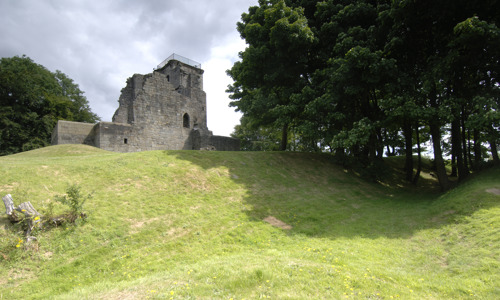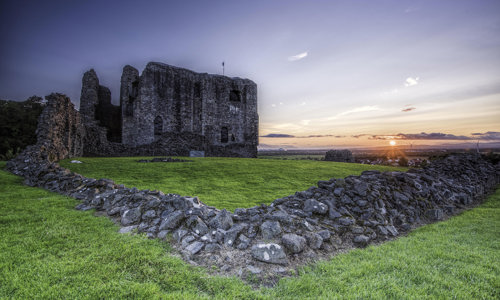History
Newark Castle was for a long time hidden behind the giant cranes and sheds of the Clyde’s great shipyards. Only recently has it re-emerged to take its rightful place in the townscape of Port Glasgow.
The land on which the castle is built was acquired by marriage in 1402 by a junior branch of the Maxwells, a powerful southern Scottish family. They remained its lords until 1694.
Everything we see today is the Maxwells’ handiwork. The name ‘new wark’ (meaning ‘new building work’) came into use in the later 1400s, when the oldest part of the present complex was built.
The first castle
Sir George Maxwell built the first castle on gaining the barony of Finlaystone from his father in 1478, and was then styled ‘of Newwerk and Finlanstone’.
The tall tower house at the south-east corner and the gatehouse on the courtyard’s west side are his work. (Gun holes shaped like inverted keyholes confirm the construction date.) Despite later changes made to them, these two structures remain fine examples of the late-medieval Scottish tower house residence.
James IV was an early visitor to Newark. He stayed here in 1495 before setting sail for the Hebrides to impose royal rule there.
The remodelled castle
Sir Patrick Maxwell remodelled the castle, having become laird in the 1580s. The date 1597 appears above the front doorway.
Sir Patrick appears to have:
- removed the earlier great hall, along the north side of the courtyard
- built a new self-contained residence in place of the great hall
- included the old tower in the new complex
Sir Patrick’s handiwork is an essay in Renaissance architecture. Newark is among the best secular buildings to survive from that period.
Executed in warm red sandstone, it combines in a masterful and exquisite way:
- projecting angle-turrets
- crow-stepped gables
- cable mouldings
- pedimented windows and doorways
A nasty piece of work
Sir Patrick’s building work may have been refined, but he was anything but. He murdered several neighbours – including two of the Montgomery of Skelmorlie family in one day. He even killed his own kin.
But his most sorry victim was his wife, Lady Margaret Crawford. Even Patrick’s own mother took pity on her, lodging a complaint about her son’s conduct with the Privy Council in 1595.
Lady Margaret tried to have her “unkind and unnatural husband” restrained, alleging that he had attacked her with a sword, and kept her locked in her chamber for six months, with only bread and water to live on.
After 44 years of marriage and 16 children together, Lady Margaret finally fled across the Clyde to Dumbarton, where she died. Sir Patrick was never called to account.













